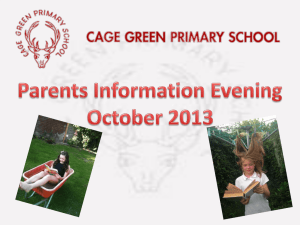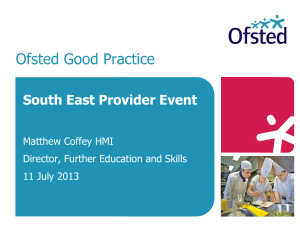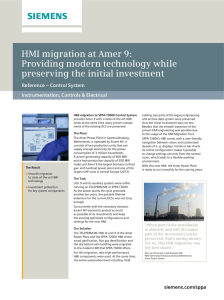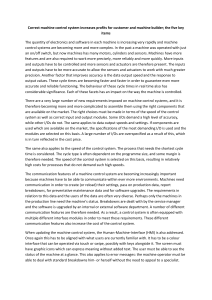Hello from Hyderabad…
advertisement
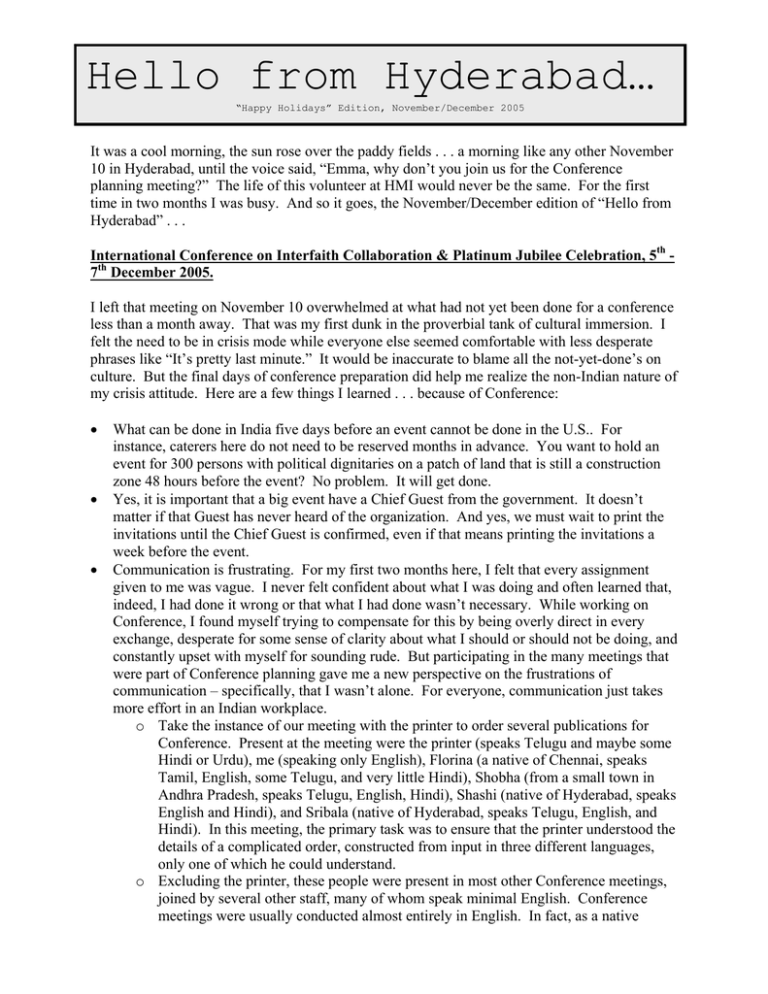
Hello from Hyderabad… “Happy Holidays” Edition, November/December 2005 It was a cool morning, the sun rose over the paddy fields . . . a morning like any other November 10 in Hyderabad, until the voice said, “Emma, why don’t you join us for the Conference planning meeting?” The life of this volunteer at HMI would never be the same. For the first time in two months I was busy. And so it goes, the November/December edition of “Hello from Hyderabad” . . . International Conference on Interfaith Collaboration & Platinum Jubilee Celebration, 5th 7th December 2005. I left that meeting on November 10 overwhelmed at what had not yet been done for a conference less than a month away. That was my first dunk in the proverbial tank of cultural immersion. I felt the need to be in crisis mode while everyone else seemed comfortable with less desperate phrases like “It’s pretty last minute.” It would be inaccurate to blame all the not-yet-done’s on culture. But the final days of conference preparation did help me realize the non-Indian nature of my crisis attitude. Here are a few things I learned . . . because of Conference: • • • What can be done in India five days before an event cannot be done in the U.S.. For instance, caterers here do not need to be reserved months in advance. You want to hold an event for 300 persons with political dignitaries on a patch of land that is still a construction zone 48 hours before the event? No problem. It will get done. Yes, it is important that a big event have a Chief Guest from the government. It doesn’t matter if that Guest has never heard of the organization. And yes, we must wait to print the invitations until the Chief Guest is confirmed, even if that means printing the invitations a week before the event. Communication is frustrating. For my first two months here, I felt that every assignment given to me was vague. I never felt confident about what I was doing and often learned that, indeed, I had done it wrong or that what I had done wasn’t necessary. While working on Conference, I found myself trying to compensate for this by being overly direct in every exchange, desperate for some sense of clarity about what I should or should not be doing, and constantly upset with myself for sounding rude. But participating in the many meetings that were part of Conference planning gave me a new perspective on the frustrations of communication – specifically, that I wasn’t alone. For everyone, communication just takes more effort in an Indian workplace. o Take the instance of our meeting with the printer to order several publications for Conference. Present at the meeting were the printer (speaks Telugu and maybe some Hindi or Urdu), me (speaking only English), Florina (a native of Chennai, speaks Tamil, English, some Telugu, and very little Hindi), Shobha (from a small town in Andhra Pradesh, speaks Telugu, English, Hindi), Shashi (native of Hyderabad, speaks English and Hindi), and Sribala (native of Hyderabad, speaks Telugu, English, and Hindi). In this meeting, the primary task was to ensure that the printer understood the details of a complicated order, constructed from input in three different languages, only one of which he could understand. o Excluding the printer, these people were present in most other Conference meetings, joined by several other staff, many of whom speak minimal English. Conference meetings were usually conducted almost entirely in English. In fact, as a native English speaker, I – the foreigner - am one of the few people in the office who can listen and speak in a meeting without needing to translate my thoughts and spoken words between multiple languages. o I felt the burden of verbal misunderstanding in just about everything I did in preparation for Conference. And I frequently heard others in the office trying to clarify their own misunderstandings. In the letter I wrote before coming to India, I expressed my desire to come to a place where I would be in the minority physically, culturally, linguistically. In the last three months, and especially while preparing for Conference, I realized that being in the linguistic minority is part of daily life for an Indian. Every venture outside the house runs the risk (and usually the guarantee) of an encounter with someone who won’t understand what you say. I suppose it’s very American of me to even call it a “risk”. I wonder about what goes through an Indian’s mind when approaching a store clerk or someone on the street, not knowing whether to speak Hindi or Telugu or Urdu or perhaps another regional language like Tamil. I find myself hesitant to talk with certain persons at the office, or reluctant to approach a new guest in the hostel, for fear that an awkward moment will arise when we cannot understand each other. I’ve been here three months. If such awkward moments did occur, I don’t remember them. Perhaps in hindsight it’s not awkward; it’s just India. The opportunity to work on Conference launched me head first into the workings of Henry Martyn Institute. As frustrating as it was, I could not have asked for a better way to learn about the internal dynamics of HMI, to see how HMI is present in the world, and to consider the issues HMI confronts because of these circumstances. Guests attended the Conference from across India, the United Kingdom, United States, Canada, Netherlands, Germany, and Sweden. Historically, Henry Martyn Institute began as a school supported by churches outside India, existing primarily as an academic institution, with students from India and other countries. In the last 15 years, HMI added a Praxis (or practical) programme that includes community work locally in Hyderabad and conflict resolution work throughout India. Much of HMI’s practical work happens through partnerships with local NGOs like Nagaland Development Outreach, Peace Core Team Manipur, or B.E.S.T. in the tsunami project. HMI’s funding partners are primarily “white” and “western”. Grassroots partners are primarily Indian and from organizations, some of which struggle to afford travel to Hyderabad. In addition to the distinction between funding partner and working partner, there is also the difference between partner in praxis and partner in academics. Students at HMI come from universities and seminaries all over the world. To the Professor from Sweden who sends her masters students to study here, HMI appears differently than to the social worker who leads life-skills classes in a tsunami-affected village. When all these people come together for an event like Conference or a Platinum Jubilee Celebration, the scope of HMI becomes apparent, and with it the unique challenges and opportunities that accompany the mission of an “International Centre for Research, Interfaith Relations, and Reconciliation,” with its roots in the evangelical church, and its future in a rapidly-changing India. This is an exciting, frustrating, and challenging time to be in this organization. There is amazing work being done in the name of Henry Martyn Institute. Please pray for the continued transformation and organization of HMI into a more effective instrument of peace and healing. Economy of Gas Dinner at the office Christmas party is usually cooked by the hostel staff. This year it was catered. The reason? No extra gas to run the stoves for such a large meal. The stove in the hostel’s small upstairs kitchen, where residents can cook or heat water, has been unusable for the last 6 weeks. The reason? No gas. Gas for cooking is delivered each month in red canisters which are brought into the kitchen as needed, attached by a hose to the stove, and used until empty. Prior to the gas shortage, the hostel used each cannister as needed and placed an order for more when the supply was low. The current gas shortage across Indian has resulted from a combination of factors, including low supply and a government initiative to regulate the size and price of gas cannisters for commercial institutions (like hotels, hostels, restaurants). The low supply is serious enough that the cook and several other staff brought their own personal gas cannisters to work so the hostel kitchen could maintain operation. In a breakfast discussion about the gas situation, an Indian said to me, “You probably don’t have this problem in the U.S..” My thoughts turned to the headlines that frequented U.S. newspapers in recent winters, “Elderly must choose between food and heat,” and to the social service agencies that spend most of their utility assistance budgets in the winter months to help clients pay rising costs of heating. I responded to the question, “Actually we do deal with gas shortages, but there are a few differences.” First, the recent gas shortages in the U.S. aren’t nearly as severe. Second, gas is rarely essential for cooking in the U.S., as most families have an electric stove and/or a microwave. (In India, relying on either of the above would affect cooking more than a gas shortage because electricity lapses occur far more often.) But another difference is most revealing. “In the U.S.,” I said, “we don’t have gas shortages, we have increased gas prices.” This distinction without a difference reflects a significant difference in the American and Indian economic culture – it’s the difference between responding out of abundance and responding out of sacrifice. Of course, the economic principle is simple – supply shortage leads to price increase. Generally speaking, Americans focus on the latter part of that equation, speaking of how much more it will cost rather than of doing without. Maybe I’m making too strong a generalization here. The current gas situation in Hyderabad, because of government interference, is actually restricting supply of gas on the open market, irrespective of what price buyers are willing to pay. Even so, the economy of gas is revealing. Voices from Manipur They arrived on November 5 after traveling five days by train and bus - fifteen pastors from the state of Manipur in North East India. After a morning at the city library, I got off the bus that Saturday afternoon, walked down the lane to the hostel, and saw them pass in two white taxis with Chonmi waving out the window. Chonmi, from Manipur, and I know each other from the workshop we both attended during my first weeks here. He returned to HMI in November as the coordinator for the pastors’ trip. At first, I thought these were fifteen pastors, coming to HMI for professional development in conflict resolution and a retreat from conflict-ridden Manipur. It wasn’t until a few days later that I learned the seriousness of their time at HMI. The pastors represented two opposing sides of a conflict within the Tangkhul Naga Baptist Church. Naga is a people group in North East India, an area of Indian states surrounding Bangladesh and connected to the rest of India by the land to the north of Bangladesh. People from the North East are predominantly of Mongol background, with cultures, languages, and physical appearances that set them apart from the rest of India. Tangkhul is a tribe of the Naga living in Manipur. The state of Nagaland borders Manipur. 8% of the Manipur population is Naga. One of the most significant political pressures and sources of conflict in the North East is an effort to unite all Nagas under one administrative unit and for this unit to become a sovereign country, separate from India. Nagaland’s population is 98 % Christian. “Church” in Manipur or Nagaland almost always refers to the American Baptist Mission (ABM), though the Catholic Church and Seventh Day Adventists are also present in the region. Most of the Nagas in Manipur are Baptist. The Baptist Church in the North East has its origins as a mission church of the American Baptist Church. Even though it is now a fully separate body, with local leaders and institutions, most Baptists in the North East still identify their denomination as “ABM”. Previously, the ABM in Manipur was made up of smaller churches in each village. The churches of the Tangkhul tribe then joined into one association. For administrative purposes, this association established four zones – north, south, east, and west – each of which included all the local churches in that zone. This was a federal model of church organization, with regional units and a central administration. In more recent years, a movement arose in the church to replace the zones of the federal model with a single administrative unit to which all local congregations were accountable. The story that follows, in simplified version, is this: Two of the four zones chose to adopt the newer model and formed a separate church association. Two did not. This group was accepted into the North East Convention of Baptist Churches, an organization with religious, social, and political power in the North East. The other two zones did not join the new structure model and have thus been excluded from the region-wide Convention. Within each zone, certain congregations and certain church members fall on either side of the debate over church structure. In many situations, the pastors are caught in the middle. The fifteen pastors who gathered at HMI represent the “opposing” sides of this conflict. In their own congregations, they are dealing with the threat of a permanent split in the church, church members leaving ABM to join other churches, families and villages divided over the issue. I learned about the situation by speaking to Robinson, a member of the Tangkhul Naga Baptist Church, and a conflict resolution facilitator at HMI who recently moved to Hyderabad from Manipur. I explained that I don’t fully understand how much a division in the church affects the daily lives of people in his home. Robinson gave the example of his own family, and the division between he and his brother who feel differently about the church structure issue. He used Christmastime as another example, sharing that within a village (of anywhere from 15 to 600 families), the Baptists celebrate holidays differently from the Catholics and other Churches. Thus, when Tangkhul Naga Baptist Church members leave and join other churches, this means they no longer celebrate holidays with the same people or in the same way. (Robinson was careful to clarify that prior to the recent church structure debate, the different celebrations among Baptists, Catholics, and Seventh Day Adventists was not a problem because the differences arose from choice, not from hurt feelings and tension which is the cause of the current divisions among Baptists. The fifteen pastors who came to HMI spent almost 8 days in sessions to learn about dealing with conflicts and finally spent two days and long nights in intense mediation on their specific conflict. The end result was a plan with which they returned to their home. In the month and a half since they came to HMI, they’ve taken several steps in that plan. HMI facilitators will go to Manipur in January for further sessions. This is one of the first instances in which HMI has become involved in mediating a specific conflict; HMI usually focuses on training local leaders from various conflicts and organizations. In trying to tell this story, I realize how little I know about the situation and how poorly my knowledge can convey the delicate nature of what is going on with the Baptist Church in Manipur. When I think of a church division, the first thought that comes to mind is the movement within the Episcopal Church threatening to split over the issue of ordaining homosexual clergy. And with this thought comes images of some Episcopal church leaders condemning each other’s theology, setting up headquarters to mobilize their forces, print literature, and move their agenda. Perhaps there are similar efforts on both sides of the Tangkhul Church issue, but if so, the pastors who came to HMI are an exception. I was surprised to learn that they come from opposing sides because the fellowship they exhibited was anything but opposing. North East Indians are known for musical ability. These pastors sang and sang and sang, in beautiful harmony, morning and night. During their stay, the pastors led the HMI devotion each morning. For a week, the prayer hall rang with their voices. They toured the city together, ate together, prayed together, walked together. Robin explained that many of them were dear friends caught up on “opposing” sides of the church’s debate. Witnessing their presence here taught me that conflict looks very different in the midst of fellowship. To Give or Not to Give One Sunday afternoon, Ruth and I sat down for a conversation we’d begun earlier, but decided to continue when we were alone. It began with the question, “Have you loaned money to anyone at HMI?” The answer from both of us was “Yes.” Most of our conversation focused on one person in particular, who in the last month had asked both Ruth and I to loan her money. She works in the hostel and lives on campus. Both Ruth and I are fond of her and her children. She first asked me for Rs. 100 (Rs.= rupees) one evening when I visited their home after work. She was careful to ensure that I wouldn’t tell the hostel management about her request. I was reluctant to give, not because of the amount – a significant amount for her but less than $3 for me, neither did I worry about how it would be spent – she could definitely use extra money, but because I didn’t want loaning money to become part of our relationship. As promised, she returned the Rs. 100 out of her paycheck a couple weeks later. Within another two weeks, she asked to borrow Rs. 200. This time I was very reluctant. She’d already given Rs. 100 of the first paycheck to pay me back for the first loan. Now she was asking for twice the amount. That would mean even more coming out of her next paycheck. I didn’t want her to become trapped in a cycle of debt. I loaned her Rs. 100. She paid me back the next week. Ruth had loaned a larger amount, but had similar concerns. How will it affect our relationship with the friend? How will it affect her financially to borrow these small amounts? Both of us felt that our money was being used as a short term fix and that she would continue to need to borrow money. We would have gladly slipped a Rs. 100 bill under her door each month with no expectations of repayment, but how would this affect our friend in the long run or when we leave HMI? Despite these concerns, if I know I have more money than I need and a friend feels that she has less than she needs, what right do I have to question whether she’ll still need money next week? After all, next week I’ll still have more money than I need, so what gives me the right to be her financial counselor? These are some of the questions we talked about. We had both struggled with whether to give the money, and it wasn’t about the money. But maybe it was about the money. Ruth and I both talked about the discomfort of being seen as someone with money. We both acknowledged how uncomfortable our friend must feel when asking us for a loan. Still, one of the discomforts of being white in Hyderabad is being perceived as someone with great wealth. But that perception – the one that makes me uncomfortable – is entirely accurate. I am wealthy. The question that I should be asking is “how did I go this long in life without feeling uncomfortable because of my wealth?” People without wealth face the discomfort of their financial circumstances everyday. Sometimes it’s the physical discomfort of not having enough to eat. But there are many people living in between “starvation” and my situation. For instance, most of the Conflict Resolution students at HMI are all staying in the hostel during their two-week Christmas break. Why? In large part because they can’t afford the cost of a plane ticket home, and travelling only by train will take 4 days one way. On occasion, I’ve felt uncomfortable when going out to dinner twice in a week. But what about the discomfort the other residents feel when they want to go get away from the campus but know that it’s not in their budget. There is no right or wrong answer to the question of whether to loan money. There are positive and negative implications to either choice. Ruth and I both said, “We don’t mind giving money, it’s just that being asked puts us in an uncomfortable situation.” Of course it does. Having so much more money than the people I live with should make me uncomfortable. Maybe there is no comfortable way to deal with such extreme inequality of wealth. When it Rains it Pours The newspaper headline on Dec.19 read “TN Stampede Kills 42”. TN is Tamil Nadu, the state south of Andhra Pradesh, and home to coastal areas devestated by last December’s tsunami. Chennai (or Madras) is the state capital. For the last two months, the state has suffered extreme rains and flooding. According to the article, the stampede occurred “in the early hours of Sunday when rain-affected poor people gathered at a government higher secondary school . . . in South Chennai to collect tokens for flood relief materials.” It was the second stampede in the last six weeks to occur at a rain-relief collection center. (Deccan Chronicle) HMI is involved with a tsunami relief project in the Nagapattinam district of TN, working in collaboration with the U.S.-based Mennonite Central Committee and B.E.S.T., a local NGO. Subhash is HMI’s project officer in the district. About once a month he returns to the Hyderabad office. According to Subhash, the effects of flooding in the coastal district are even more devastating than the tsunami. Nearly a year after the tsunami tragedy that touched the entire world, these communities were rebuilding their lives, their agriculture, their ways of life. In the last two months, flooding has virtually destroyed the re-excavated canals, reclaimed salt pans (a major local industry), restored agricultural land, and community water systems. Even so, flooding has not ruined all progress towards long-term recovery after last year’s tsunami. What has not been destroyed are the lives transformed by extensive trauma counseling and livelihood training, a large part of HMI/BEST’s work in Nagipattinam. HMI’s tsunami project began in January 2005. It is planned as a two-year project. In the midst of repeated tragedies, unceasing rains and destruction, Subhash always returns to Nagipattinam. His colleagues return. The villagers with whom he works never left. They still wake up every morning and face the day ahead. What I am about to say about India I say not as a clever pun, but with all sincerity. I’ve not known a place where the cliché rings so true – “when it rains, it pours.” I suppose this cliché is the definition of India’s monsoon season, but it is true not only in reference to the weather. Perhaps it seems this way to me because so many people here live in stark poverty, so any difficulty on top of that seems like a rainstorm after the flood. There’s another cliché, though, that has come to mind more often since I landed in Hyderabad. It is the saying that “Life goes on.” India is teaching me to consider the possibility that life really does go on. It is a lesson taught by the mothers in Nagipattinam who lost all of their children to a devastating wave and now see their rebuilt homes destroyed by flooding. It is taught by the beggar covered in sores, sitting alone on the pavement, whose age of at least fifty years prompts me to wonder how he survived this long, to wake up each day to this? And it’s taught by the less drastic but persistent burdens that people here endure every day: Police officers who stand in the middle of intersections, directing chaotic traffic for hours and inhaling extreme pollution; The woman who lives in decent housing but still must carry water to her home everyday - for the rest of her life - from a pump 50 meters away.; A family of seven grown adults living in a house with a small kitchen and one 10ft by 12ft room; Offices in which everyday the internet may or may not be working; The successful professional who works with international colleagues but cannot imagine traveling to the U.S. or Europe because those places don’t value his currency; The peace worker from Pakistan who has tried for the last two years to attend a workshop at HMI but could not get a visa from the Indian government because his passport says Pakistan. At first glance, these differing situations hardly seem comparable. How does the difficulty of travelling internationally compare with the burden of carrying water long distances so your family can eat? I mention these situations together because, prior to coming to India, I would have considered any of them to be burdens to overcome. How can we expect anyone to live in such conditions, or with such limitations? I still feel that if I had to endure any of these situations, I would consider them a challenge to overcome so that I could “get on with life.” But in India, I daily encounter people for whom these challenges are part of life, not something to get over. Life is no less life when it’s lived in these circumstances. Sympathy should not be my only reaction to every person who lives in a roadside tent. Of course, I should not assume they prefer to live that way. But I must respect that they are no less alive and engaged with the world simply because they live in circumstances that I tend to see as targets for sympathy. These thoughts are related to the concern I raised in the September newsletter I can see that my time in India or any foreign culture will be defined in large part by how I cope with this question. “How can you possibly be happy in the midst of this?” I realize now that what I am really asking is “How can you possibly be alive in the midst of this?” This question is far more offensive . . . offensive to life, to people who live it, and to the God who created it. I can see that my time in India will be defined in large part not by the answers I find, but by how I am able to ask more respectful questions. Dutch Cartoons and HMI • • In September, Jyllands-Posten, a Dutch newspaper, invited readers to submit drawings depicting the Muslim prophet Mohammed. In late November, two conflict resolution facilitators at HMI – Varghese and Florina were planning a December trip to do field work in India-occupied Kashmir. What do these two things have in common? I didn’t know either until Varghese stepped up from his desk and said, “Kashmir workshop is cancelled.” It was the first week of December. He had just received a phone call from HMI’s partner at the organization in Kashmir. The situation in Kashmir had grown too dangerous for the workshops after violent protest broke out in response to some cartoons of Mohammed that appeared in a Dutch newspaper. A Pakistani group, described as nationalist and fundamentalist, issued a bounty on the head of whoever drew the pictures and also spread protest against the drawings through the media. Florina and Varghese are trying to reschedule their trip to Kashmir. ‘Tis a small world after all. A few anecdotes to say Happy Holidays! • As I put the finishing touches on this newsletter (December 21), my parents and sister are less than 24 hours away from embarking on a non-stop flight from Chicago to Delhi. I will leave Hyderabad early tomorrow morning to meet them at the airport. You know what they say, Christmas isn’t Christmas without the Taj Mahal. We will spend a few days in Delhi, then on to Agra and Udaipur in Rajasthan before returning to Hyderabad to bring in the New Year. I am excited to be with them and to explore more of India. Stay tuned for scenes from the road. • My first Christmas celebration in Hyderabad occurred last Friday at the HMI Christmas party. This year the party happened outdoors, with a small tree decorated with garland and balloons, a nativity set displayed in a crib made of hay, two live cows that we thought might eat the crib, and a small fire. The students and a few others led singing and shared about the origins of Santa Clause and Christmas Carols. Aca dressed as Santa. Along with Athing from Manipur and Poonam from West Bengal, I told about how I celebrate Christmas at home. First, I asked the kids to imitate me as a child on Christmas morning – “jump up like you’re jumping out of bed and pretend to gaze out the window in search of snow.” “Then,” I said, “I would run to my parents’ bedroom to wake them up for Christmas morning.” As soon as these words came out I hesitated, realizing that most of these kids, as is custom in India, sleep in the same bed with their parents. • At HMI I live with Indian students from the North East and Kashmir who are far from home this Christmas, the distance measured in kilometers but also in culture, weather, and separation from family. We’re all away from what we know as Christmas. (Somehow, the girl from another continent gets to be with her family.) It’s a lesson for me in the significance of home. • One evening I accompanied a friend who was shopping for Christmas gifts. She is Hindu and wanted to give gifts to her Christian friends. She also exchanges a gift with her husband on Christmas. I asked, “which holiday is the biggest for you?” She responded, “None, really. We celebrate everything, so no one holiday is bigger than the other.” I definitely get that sense from south India. In the October newsletter I commented on the abundance of celebrations in India and wrote: “But I realize now that celebration looks different in my culture, where we spend months looking forward to one-day holidays.” From my reaction to South India, I get the sense that I prefer to spend months looking forward to Christmas and that the “looking forward” is part of the celebration. I confess it is difficult to send a Christmas message because I don’t feel the season. Celebration comes easy among the routines of home, few of which are present here. The voice in my head is saying, “Emma, enjoy your traditions, but a true celebration of Christmas must transcend tradition.” I’m not there yet, to a truer celebration of Christmas, but I hope to be one step closer when I return to the traditions next year. In the mean time, I hope you will find holiday cheer in the “looking forward” to this Christmas and next year, when I’ll perform a rousing medley of Christmas Carols in Telugu. See, there is a silver lining in every proverbial tank of cultural immersion. Happy Holidays!

